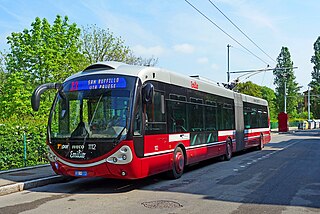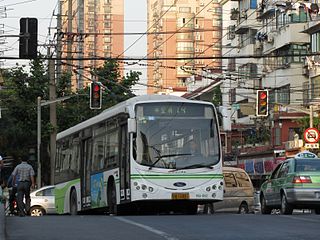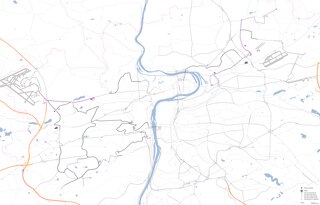
A trolleybus is an electric bus that draws power from dual overhead wires using spring-loaded trolley poles. Two wires, and two trolley poles, are required to complete the electrical circuit. This differs from a tram or streetcar, which normally uses the track as the return path, needing only one wire and one pole. They are also distinct from other kinds of electric buses, which usually rely on batteries. Power is most commonly supplied as 600-volt direct current, but there are exceptions.
There have been two separate generations of trams in London, from 1860 to 1952 and from 2000 to the present. There were no trams at all in London between 1952 and 2000.

Le Havre tramway is a modern two-line tram system in the city of Le Havre in Normandy, France. The modern tramway opened on 12 December 2012.
The Mexborough and Swinton Traction Company was the name adopted by the Mexborough & Swinton Tramways Company in 1929 following the introduction of trolleybuses on all its routes. It operated in the West Riding of Yorkshire, England, over routes serving Manvers Main Colliery, Wath upon Dearne and the towns of Rotherham, Rawmarsh, Swinton, Mexborough, Conisbrough and the estate at Conanby.

The Mérida trolleybus system was an electrified bus rapid transit system that served Mérida, Venezuela, and surrounding communities from 2007 to 2016. Its only line, which was operated by dual-mode trolleybuses, was considered to be "Line 1" of a planned three-route "Mass Transport System", of which Line 2 was also to be trolleybus and Line 3 an aerial cableway. Line 3 was originally planned as a funicular, but was changed to a cableway in 2005. Construction of line 3, the cableway, was about 50 percent complete as of May 2011, and the cableway opened for service on 14 December 2012. Construction of Line 2 never started. The operator of the system was originally named Trolmérida, but in August 2009 its name was changed to Tromerca, for Trolebús Mérida, C.A.

Public transport in Tallinn consists of bus, tram, trolleybus, train and ferry services. Bus, tram and trolleybus routes are mainly operated by Tallinna Linnatranspordi AS. Electric train services are offered by Elron and the ferry service to Aegna island is operated by Kihnu Veeteed.

The Rome trolleybus system forms part of the public transport network of the city and comune of Rome, Italy. In operation since 2005, the current system comprises three routes.

The Bologna trolleybus system is part of the public transport network of the city and comune of Bologna, in the region of Emilia-Romagna, northern Italy. While being in operation since 1991, the current system comprises five urban routes: 13, 14, 15, 32 and 33. Additional routes are presently under construction.

The Modena trolleybus system forms part of the public transport network of the city and comune of Modena, in the region of Emilia-Romagna, northern Italy.

The Seattle trolleybus system forms part of the public transportation network in the city of Seattle, Washington, operated by King County Metro. Originally opened on April 28, 1940, the network consists of 15 routes, with 174 trolleybuses operating on 68 miles (109 km) of two-way parallel overhead lines. As of the second quarter of 2022, the system carries riders on an average of 34,800 trips per weekday, comprising about 18 percent of King County Metro’s total daily ridership. At present in Seattle, a very common alternative term for trolleybus is trolley.

The Santos trolleybus system forms part of the public transport network in Santos, a municipality in the state of São Paulo, Brazil. Opened on 12 August 1963, it presently comprises only one line, and, along with the two São Paulo metropolitan area trolleybus systems, is one of only three trolleybus systems still operating in Brazil.

The Shanghai trolleybus system is a system of trolleybuses forming part of the public transport network in the city of Shanghai, China. Of more than 300 trolleybus systems in operation worldwide, the Shanghai system is the oldest. The system turned 100 years old in November 2014 and was the first trolleybus system anywhere in the world to reach that milestone.

The Rimini trolleybus system, also known as the Rimini–Riccione trolleybus line, forms part of the public transport network of the city and comune of Rimini, in the region of Emilia-Romagna, northern Italy. In operation since 1939, the system links Rimini with the nearby seaside resort and comune of Riccione.

The Zürich trolleybus system is part of the public transport network of Zürich, Switzerland. Opened in 1939, it combines the Zürich S-Bahn, the Zürich tramway network and Zürich's urban motorbus network to form an integrated all-four style scheme.

Rețeaua Auto de Transport Brașov, formerly Regia Autonomă de Transport Brașov, and commonly referred to as RAT Brașov, is the only public transport operator in the city of Brașov, Romania. It is owned by the Brașov Municipality and it operates on a network of 40 routes, summing up to 664 km, with a fleet of over 225 vehicles. It also began operating on one route within the Brașov Metropolitan Area, with several new ones set to begin in the future.
As of 2012 there were around 300 cities or metropolitan areas where trolleybuses were operated, and more than 500 additional trolleybus systems have existed in the past. For complete lists of trolleybus systems by location, with dates of opening and closure, see List of trolleybus systems and the related lists indexed there.

The Montreux/Vevey trolleybus system, also known as the Vevey–Villeneuve trolleybus line, forms part of the public transport network in Montreux and Vevey, in the canton of Vaud, Switzerland. It comprises a single 12.75 km (7.92 mi) long trolleybus route along the length of the Riviera vaudoise on the north shore of Lake Geneva.

The Schaffhausen trolleybus system is part of the public transport network of Schaffhausen, capital city of the canton of Schaffhausen, Switzerland. It is also Switzerland's youngest and smallest such system.

Prague was the first city in Czechoslovakia to introduce modern trolleybuses. Only a few other trolleybus systems existed previously in the Czech lands – in České Velenice (Gmünd) and České Budějovice – using the same overhead system as the Electromote, the predecessor of all trolleybuses.

BRT Marrakesh is a bus rapid transit system that is also partly trolleybus in Marrakesh, Morocco. It opened on 29 September 2017. The system is officially known as Bus à Haut Niveau de Service de Marrakech, which equates to the English term Bus Rapid Transit, or BRT, of Marrakesh. Although the buses are equipped to operate as trolleybuses, only part of the system is fitted with overhead wiring for trolleybuses, and the vehicles operated on batteries over the other sections.


















